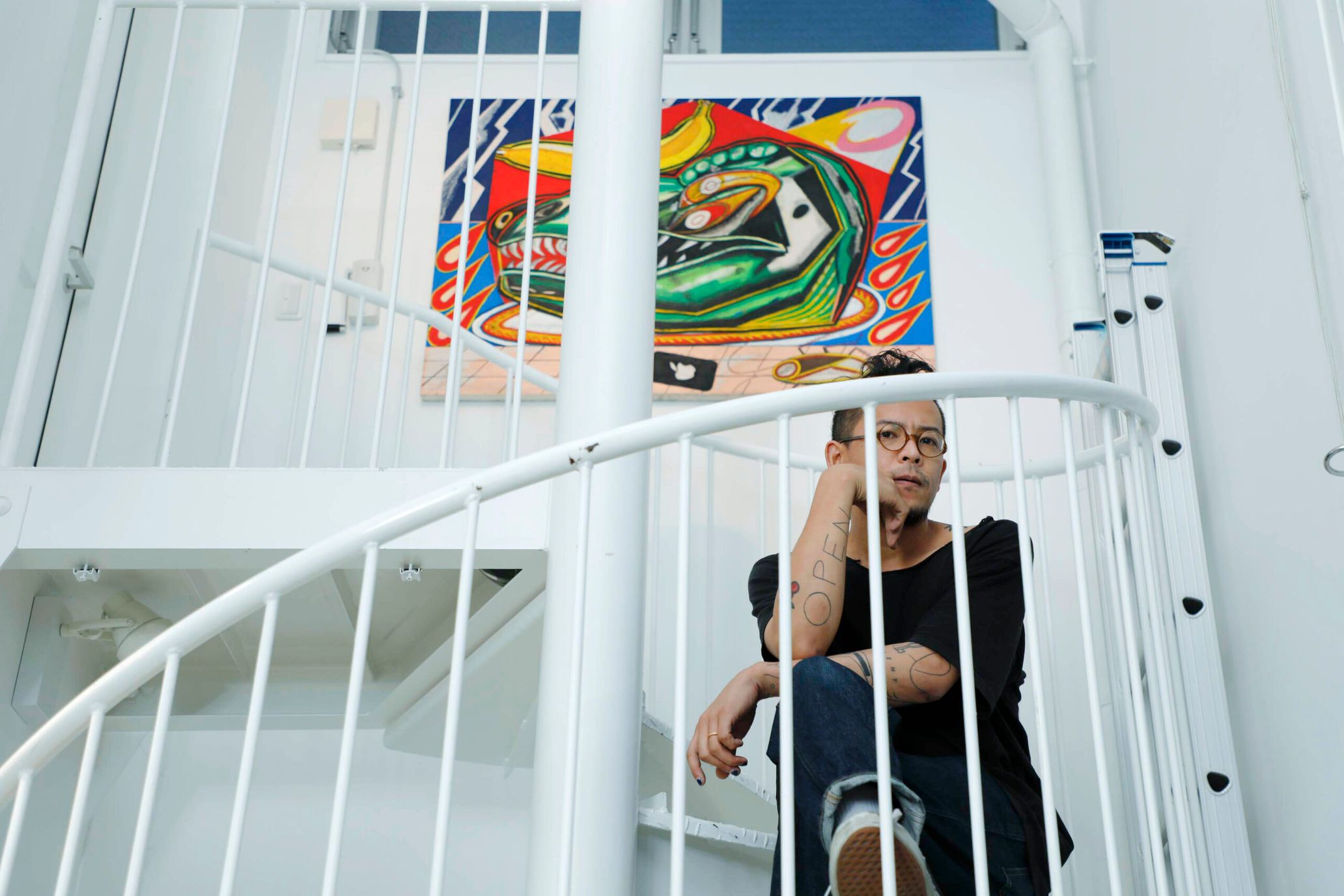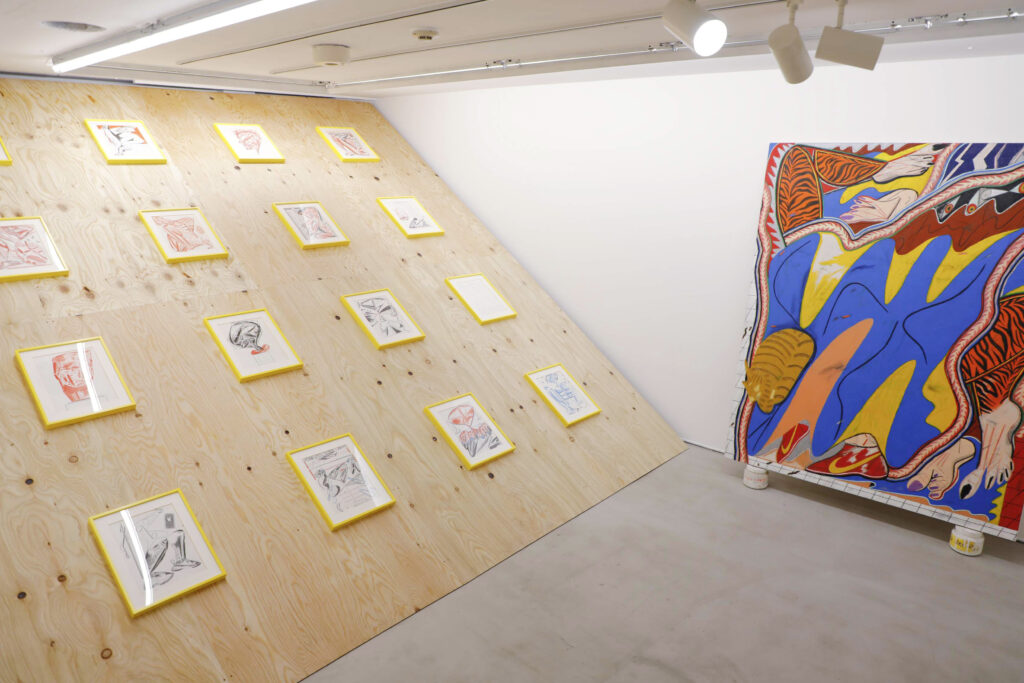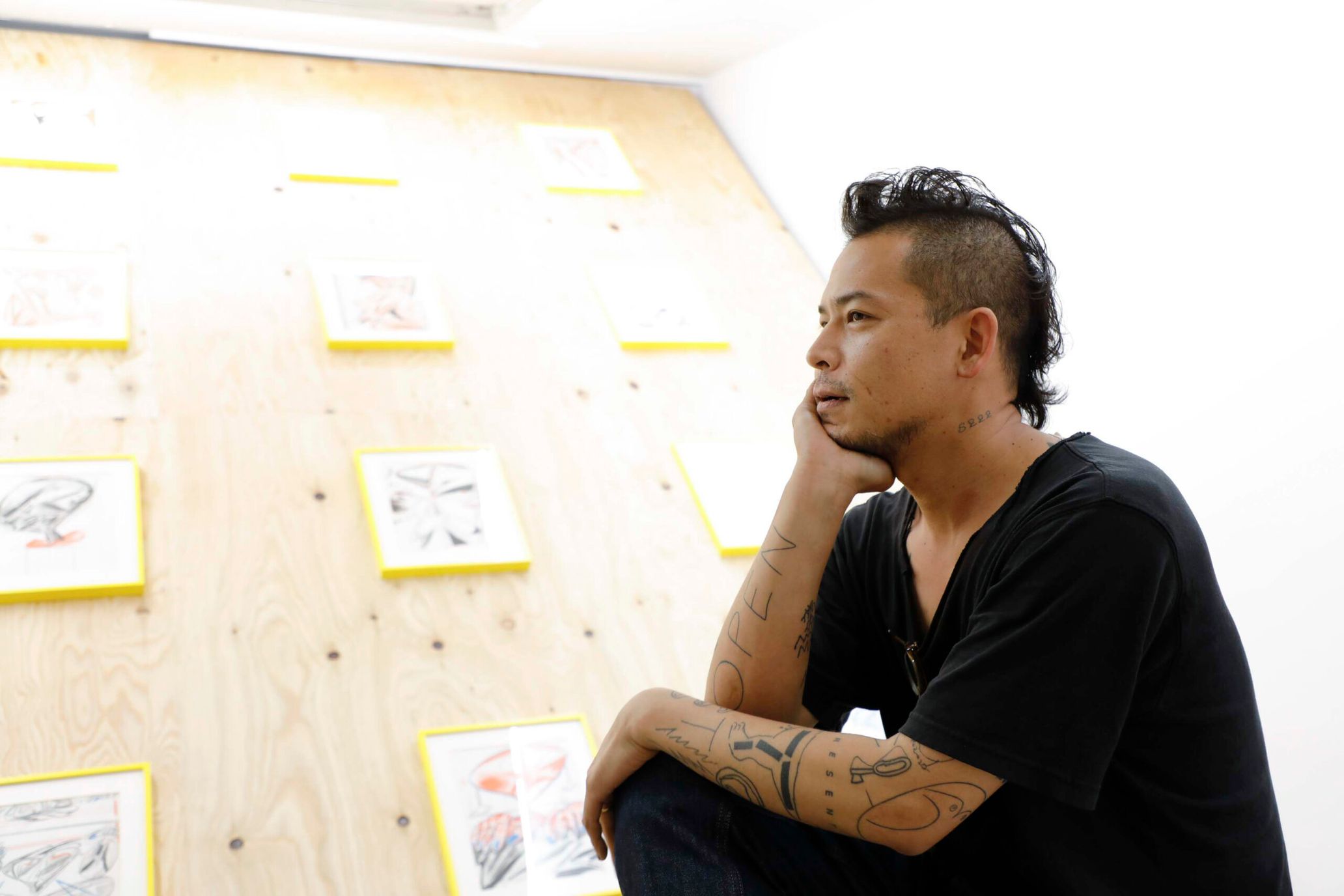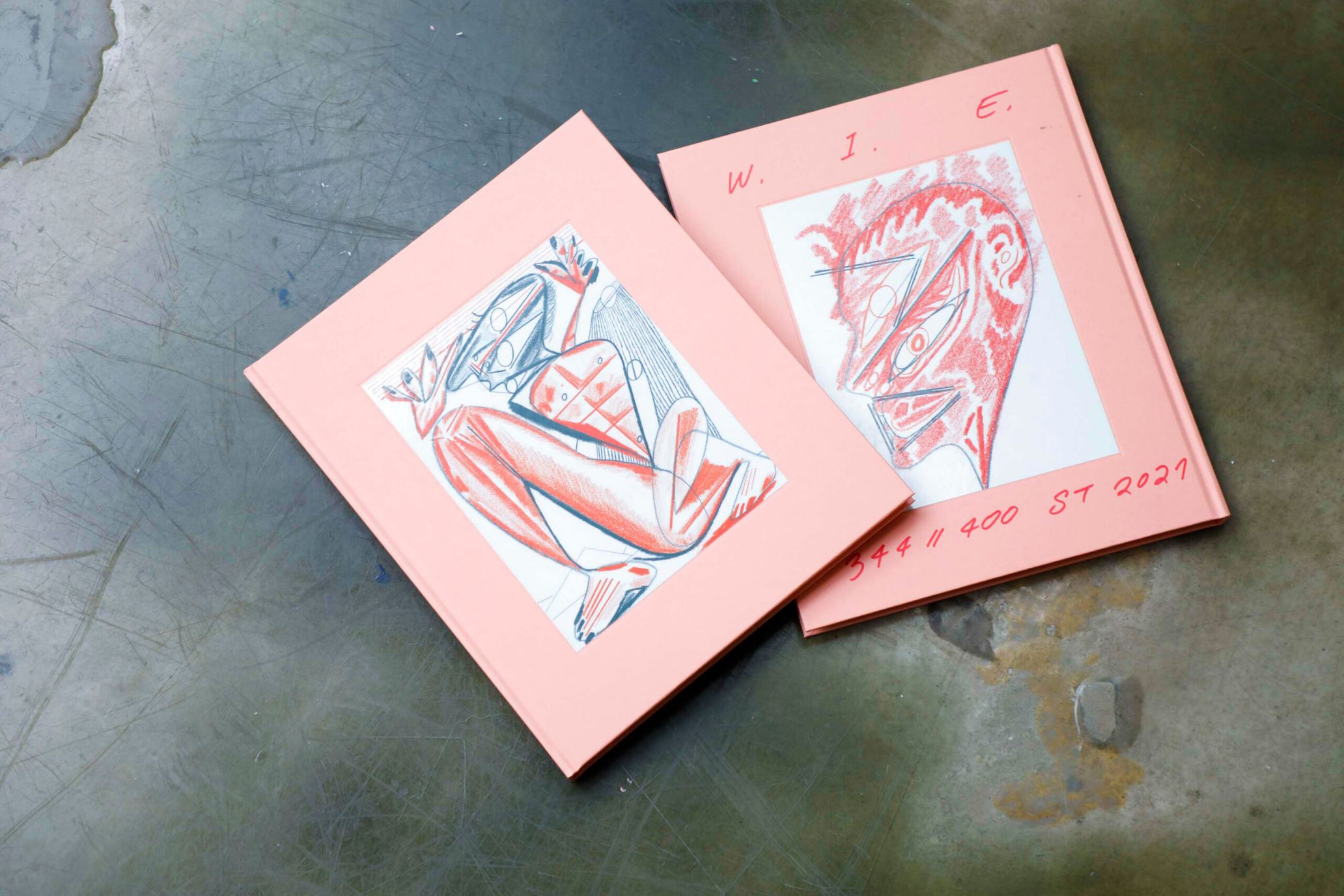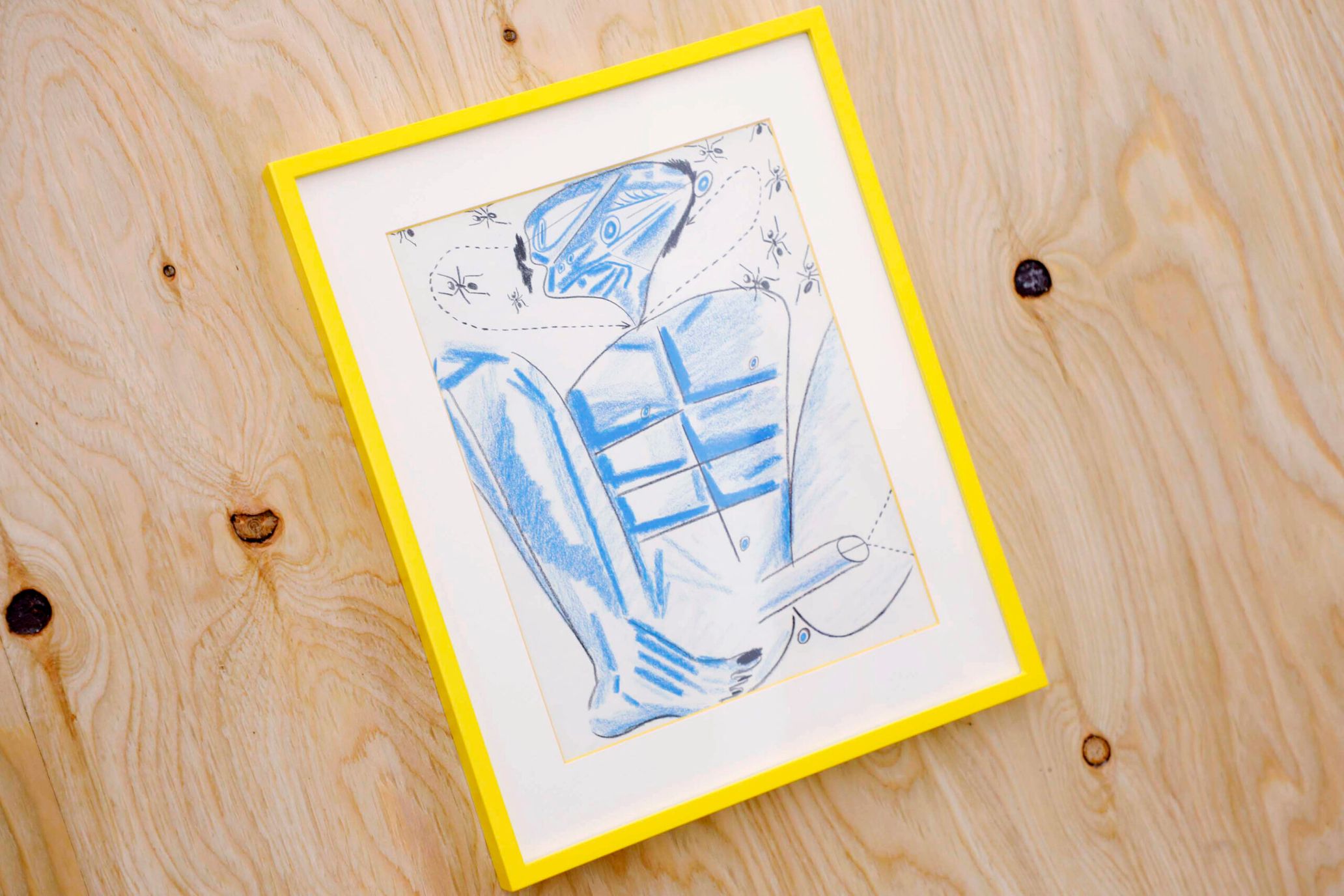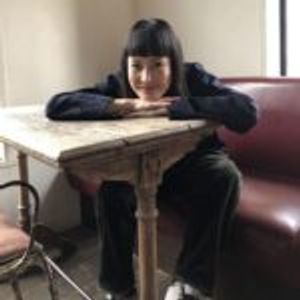Life is a truly colorful thing. Sometimes it’s subtle, and at other times, dynamic.
Artist Shohei Takasaki uses his art to express what he feels in his day-to-day life. It’s been about 10 years since he started his career in Tokyo and moved to Portland. Since then, he has grown exponentially as an artist. Recently, he compiled his work from his last two years in Portland and his two years after returning to Japan into the art book, Where is Everybody, and held the exhibition Dinosaur head, Lightning, Grid at the Ebisu book & art gallery NADiff a/p/a/r/t to commemorate the book’s publication. We went there to ask him about his career and what he wants to convey through his work.
The closer you get to something, the harder it is to comprehend. An exhibition that drew inspiration from Land Art.
ーーCould you tell us about how you started working on your art book, Where is Everybody, and what the exhibition Dinosaur head, Lightning, Grid is about?
Shohei Takasaki (Hereinafter Shohei): This exhibition has conceptual roots in an exhibition called Where did you sleep last night? that I did in Portland, right before I left the US in 2019. The gallery was a compact space, so I was thinking about how to activate it. I didn’t forcefully cram stuff into a small space, but I put a very big painting in there. A painting that was so big that it’d basically get stuck diagonally.
I did that because it represents the relationships between people. I felt like the closer you get to people you’re close to—like friends, parents, lovers, or your children, for example—the more you come to realize that they’re actually strangers to you.
In the same way, the bigger the art piece and the closer you are to it, the harder it is to comprehend the whole work. So the title, Where did you sleep last night? is about the moment where you think “What is this person really thinking?” about someone you actually trust. That comes from jealousy, or if you look at it from another perspective, love. But I did the installation wanting to convey that at the end of the day, people are actually alone.
ーーSo you mean, the closer you get to someone, the more you lose sight of them—even though they actually do have a clear shape.
Shohei: Right. I should mention that one of the sources for this show’s concept is a work by a famous American artist named Robert Smithson. He’s a conceptual artist who was a central figure in the Land art (Earthworks, Earth art) movement that emerged in the 1960s and 1970s, mainly in the US and the UK, along with Walter De Maria, Michael Heizer, and others. One of his most well-known works, Spiral Jetty, is a big spiral drawing on the ground at Utah’s Great Salt Lake. I actually went to the Great Salt Lake and saw it, and it was an art piece that opened up new ideas for me. When you stand before it, it’s a bunch of big rocks, and then just a completely dried up lake. Experiencing the work in person, it’s too big to make sense of it. That’s why the process of capturing the whole thing by looking at aerial photographs or things that were documented like blueprints from the production, is interesting. Perhaps it was the first art piece to make viewers feel a sense of time.
I was inspired by that, and I thought that if you bring Spiral Jetty to the domestic sphere, inside the home, it applies to individual relationships. The closer you get, the more you feel like, “Why are we growing more distant?”
ーーSo you did a show in Portland, which led to this art show in Japan.
Shohei: I returned to Japan after the show in Portland ended, and right away, the coronavirus pandemic happened. So, people were spending even more time at home. In my case, I was basically just going back and forth between my house and studio. My son couldn’t go to school, so he was at home, and I was with family more often. I’d returned to Japan, and just as I was being forced by circumstance to think about the meaning of home, I was asked to make an art book and do a show.
I thought it would be a good idea to present the same show and content that I did in Portland, but in a different country and land (which was Japan this time). From there, I started looking for a compact space, and I found NADiff a/p/a/r/t. I’m moving to Sydney at the end of July, but since my last two years in Portland and my two years in Japan happened to be about the same amount of time, I tried to keep the same theme but in a different place.
ーーDid you create the works in this exhibition after returning to Japan?
Shohei: I’ve been drawing a lot more because I’ve been spending more time at home due to the coronavirus. Also, I’ve been packing easy-to-carry paper and oil-based colored pencils in my bag, going to the park, and drawing while my son is playing, or drawing at my dining table after my family goes to sleep. Obviously, staying in the studio for a long time doesn’t necessarily mean you’ll make good work. (laughs) I was drawing a lot more, and after some time, I realized that I’d done a bunch of drawings.
ーーWas there anything you thought after seeing the immense number of works you had created?
Shohei: I’m able to see the relationship between painting and drawing even more than before. There are some things I’ve painted that are inspired by drawings, or on the flip side, I’ve been inspired by things I’ve painted on canvas to draw something in my kitchen. The relationship between the two is very interesting. Also, my alone time is when I’m in the studio with my canvas, whereas when I’m drawing in my sketchbook, I’m often sharing time with someone. So, there’s also the alone time versus the shared time with someone else.
“What am I?”: Learning about the art medium after becoming aware of that question
ーーYou lived in the US for many years. Did your method of creating change after moving there?
Shohei: It changed quite a bit. In my teens and twenties, I was just a little punk, so it was really just about the feeling. I didn’t care about stuff like art history, and I did it all based on a feeling, so I didn’t even know how to mount a canvas. I thought, “Why do I need to know?” or “Why not just buy a pre-stretched canvas?” (laughs) I mean, there’s nothing wrong with that. But I didn’t have many options in my head. First and foremost, it was all about having fun, or feeling good, or looking cool.
But when I started living in the US in my early thirties, I started thinking about who I was. There were different races, different languages, different ways of life, and different cultures. When people asked me, “Who are you?”, I couldn’t respond. So when I started thinking about who I was, that became, “What is an artist?” I continued working as an artist while thinking about that, and eventually, I finally realized that even art has rules and that the art we make must keep evolving. And if you’re going to hop on an art format, then you need to know art history, or else you can’t even convey what you’re doing in 2021. I started learning about art when I went to the US. Isn’t that cliché? (laughs)
ーーDid you have someone that taught you?
Shohei: In Portland, I met a guy named Theo Downes-Le Guin, who is like a mentor to me now. He also wrote the foreword for my art book. He would come to my studio once a year and talk to me all about art. He is my mentor, a friend, and a gallery owner. He’s knowledgeable about art and teaches local artists in Portland what art is. Theo was the first to critique my art directly, and he taught me all about art. I never went to art school, so I’m very thankful for Theo. The day before Theo would come to my studio, I’d think hard about what to display and how…especially in the early days. Meeting him changed the way I thought about art. Also, when I was in Portland, I went to New York a lot, so I was able to learn a lot from talking to other artists there.
ーーYou lived abroad for a while. How much of your “Japanese-ness” do you think is reflected in this collection’s works?
SHOHEI: For me, my home isn’t Japan, either. My wife isn’t Japanese, and my kid is biracial. I use Japanese when I’m in Japan, but I don’t use it that much at home, and I’ve gradually lost track of my roots. Whether I’m returning to Japan or going to Portland, I don’t feel like, “I’m home!”, so I feel like I’ve lost sight of my nationality.
ーーI feel like that’s evolution, or it’s as if you’re just a person of this Earth. I sometimes think that going forward, the borders between race and nationality will increasingly fade away. I feel like one’s lifestyle and way of thinking will be more important than ever in the future, so the feeling you expressed of not knowing what nationality you are could potentially give way to new art.
Shohei: It’s a good thing to have more choices, isn’t it? It’s easier to go abroad than ever before, and we live in a world where if you want to be involved with people from other countries, you can do that right away. I think when my son grows up, he’ll have a wider range of choices. Maybe he’ll be able to speak around 60 different languages. (laughs)
Delivering art by turning negative themes into laughter
ーーYou’re going to relocate to Australia, where you’ll be based. Are there any themes or new things you’d like to try in the future?
Shohei: I want to do more sculptures. Actually, regarding sculptures, I’ve been making them in some form every day since last year, using only things I could find in the studio. I’d fasten, glue, and pierce things on the same pedestal, then I’d take photos of that. After I took photos, I’d take them apart. I was doing that as an exercise and would keep a record that way, but I was thinking that from now on, I’d like to use wood or iron and make a piece without taking it apart. In Portland, I had a big space, so I’d cut the wood myself and make beds or tables, and it was a great mental exercise. For example, in craftwork, there’s a saying, “Measure twice, cut once.” If you make the proper preliminary arrangements and cut once, everything comes together solidly. But with painting, it doesn’t work that way. If anything, it’s the opposite. Essentially, it’s not 1+1=2. So, I want to make more sculptures because craftwork makes for a great mental exercise. Plus, when I go to Australia, my studio space will be bigger.
ーーAre there any themes you’d like to address?
Shohei: Usually, the negative or stressful things I experience in my daily life become the theme for my work, but I think when you set that theme and make it public, it’s better to add a bit of humor. When you make stress or anger the theme, it’s hard for the public to sympathize with you if you’re just angry. And a lot of the time, it’s easier to convey your feelings if you present them with some humor mixed in. The work spreads when you add a bit of laughter, or otherwise, you have to go really extreme. Things that are half-baked don’t spread. When I did an art show in Kuwait seven or eight years ago, I felt that like any country, all the young people had a lot of pent-up stress. They were mainly rich from oil money, but the government was hopeless, the rules were conservative, and there were a lot of things they couldn’t do because of religion. So when it came to fashion, they were wearing traditional white dresses and a kind of headdress (keffiyeh), but with Dickies shorts and Vans while skateboarding. That instance made me realize that the more stressed and dissatisfied you are with the system, the more seeds of creation are born.
That’s why there might be an opportunity for Japan’s creators today. But in the case of Japan’s youth, they should be more aware of the stress they’re under. Or, if they leave Japan and look at it objectively, they should be able to see that there are no other countries as crazy as Japan. There are more and more people who thought they were normal, but are starting to realize, “What is normal?” I’m looking forward to seeing what happens there.
(GALLERY COMMON)
Shohei Takasaki
Shohei Takasaki is a contemporary artist born in Saitama Prefecture in 1979. After working on album art and event flyers, he began an art career in earnest. Following a 10-year stint working in Portland, he relocated to Tokyo in the summer of 2019. There, he mainly exhibited paintings in addition to sculptures and installations. His work has been exhibited in Portland, Los Angeles, Kuwait, Melbourne, Hong Kong, Tokyo, and other cities. Additionally, his work is part of a permanent collection at the Seattle Starbucks headquarters and the Hoxton Portland. In the summer of 2021, he relocated to Sydney, Australia, where he plans to begin a new phase of his career.
http://www.shoheitakasaki.net
Instagram:@shoheitakasaki
Photography Shinpo Kimura
Translation Aya Apton

